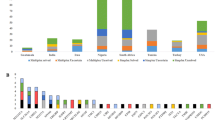Abstract
We previously mapped the DFNB17 locus to a 3-4 cM interval on human chromosome 7q31 in a large consanguineous Indian family with congenital profound sensorineural hearing loss. To further refine this interval, 30 new highly polymorphic markers and 8 SNPs were analyzed against the pedigree. Re-analysis in the original DFNB17 family and additional data from a second unrelated consanguineous family with congenital deafness found to map to the interval, limited the area of shared homozygosity-by-descent (HBD) to approximately 4 megabase (Mb) between markers D7S2453 and D7S525. Nineteen known genes and over 20 other cDNAs have been identified in the refined DFNB17 interval, including the SLC26A4 gene. We have analyzed 4 other cochlear-expressed genes that map to the DFNB17 interval as candidate genes. Analysis of coding and splice site regions of these cochlear expressed genes did not reveal any disease causing mutations. Further study of other candidate genes is currently underway.
Similar content being viewed by others
References
Morton NE, (1991) Genetic epidemiology of hearing impairment. Ann. N.Y. Acad. Sci. 630: 16–31.
Roberts J, 1968 Hearing status and ear examination: Findings among adults in the United States, 1960–1962. Rockville, Md.: National Center for Health Science, Report-Series II, No. 32
Van Camp G, Willems PJ Smith RJH, (1977) Nonsyndromic hearing impairment: Unparalleled heterogeneity. Am. J. Hum. Genet. 60: 758–764.
Greinwald JH, Wayne S, Chen AH, Scott DA, Zbar RI, Kraft ML, Prasad S, Ramesh A, Coucke P, Srisailapathy CR, Lovett M, Van Camp G, Smith RJ, (1998) Localization of a novel gene for non-syndromic hearing loss, DFNB17, to chromosome region 7q31. Am. J. Med. Genet. 78: 107–113.
Mustapha M, Salem N, Weil D, El-Zir E, Loiselet J, Petit C, (1998) Identification of a locus on chromosome 7q31, DFNB14, responsible for prelingual sensorineural nonsyndromic deafness. Eur. J. Hum. Gene 6: 548–551.
Grimberg J, Nawoschik L, Belluscio R, McKee A, Turck A, Eisenberg A, (1989) A simple and efficient non-organic procedure for the isolation of genomic DNA from blood. Nucl. Acids Res. 17: 8390.
Schaffer AA, (1996) Faster linkage analysis computations for pedigrees with loops and unusual alleles. Human Heredity 46: 226–235
Zbar RIS, Ramesh A, Srisailapathy CRS, Fukushima D, Wayne S, Smith RJH, (1998) Passage to India: The search for genes causing autosomal recessive nonsyndromic hearing loss. Otolaryngol Head Neck Surg. 118: 333–337.
Kruglyak L, Daly MJ, Lander ES, (1995) Rapid multipoint linkage analysis of recessive traits in nuclear families, including homozygosity map**. Am. J. Hum. Genet. 56: 519–527.
Robertson NG, Khetarpal U, Gutierrez-Espeleta GA, Bieber FR, Morton CC, (1994) Isolation of novel and known genes from a human fetal cochlear cDNA library using subtractive hybridization and differential screening. Genomics 23: 42–50.
Scott DA, Greinwald JH Jr, Marietta JR, Drury S, Swiderski RE, Vinas A, DeAngelis MM, Carmi R, Ramesh A, Kraft ML, Elbedour K, Skworak AB, Friedman RA, Srikumari
Homo sapiens Map View program, National Center for Biotechnology Information. June 2003 http://www.ncbi.nlm.nih.gov/mapview/maps.cgi?
Van Camp G, Smith RJH. June (2003) Hereditary Hearing Loss Homepage. URL: http://dnalab-www.uia.ac.be/dnalab/hhh/
Hogland P, Sormaala M, Haile S, Socha J, Rajaram U, Scheulen W, Sinaasappel M, de Jonge H, Holmburg, Yoshikawa H, Kere J, (2001) Identification of seven novel mutations including the first two genomic rearrangements in SLC26A3 mutated in congenital chloride diarrhea. Hum. Mutat. 18: 233–242.
Malaka S, Kere J, Holmberg C, Hogland P,.(2002) SLC26A3 mutations in congenital chloride diarrhea. Hum. Mutat. 20: 425–438.
Everett LA, Glaser B, Idol JR, Buchs A, Heyman M, Adawi F, Hazani E, Nassir E, Baxevanis AD, Sheffield VC, Green ED,. (1997) Pendred syndrome is caused by mutations in a putative sulphate transporter gene (PDS). Nature Genet 17: 411–422.
Bidart JM, Mian C, Lazar V, Russo D, Filetti S, Caillou B, Schlumberger M, (2000) Expression of pendrin and the Pendred syndrome (PDS) gene in human thyroid tissues. Clin. Endocr. Metab. 85: 2028–2033.
Lesage F, Hugnot JP, Amri EZ, Grimaldi P, Barhanin J, Lazdunski M. (1994) Expression cloning in K+transport defective yeast and distribution of HBP1, a new putative HMG transcriptional regulator. Nucl. Acids Res. Sep. 11; 22(18): 3685–8.
Pikkarainen T, Eddy R, Fukushima Y, Byers M, Shows T, Pihlajaniemi T, Saraste M and Leube RE, (1994) Human Laminin B1 chain. A multifomain protein with gene. (LAMB1)locus in the q22 region of chromosome 7. J. Biol. Chem. 262(22), 10454–10462.
Leube RE, (1994). Expression of the synaptophsin gene family is not restricted to neuronal and neuroendocrine differrenctiation in rat and human. Differentiation 56: 163–167
McMahon HT, Bolshakov VY, Janz R, Hammer RE, Siegelbaum SA, Sudhof TC, (1996) Synaptophysin, a major synaptic vesicle protein, is not essential for neurotransmitter release. Proc. Natl. Acad. Sci. U.S.A. 93: 4760–4764.
del Castillo I, Villamar M, Moreno-Pelayo MA, del Castillo FJ, Alvarez A, Telleria D, Menendez I, Moreno F,. (2002) A deletion involving the connexin 30 gene in nonsyndromic hearing impairment. N. Engl. J. Med. 346: 243–9.
Verpy E, Masmoudi S, Zwaenepoel I, Leibovici M, Hutchin TP, Del Castillo I, Nouaille S, Blanchard S, Laine S, Popot JL, Moreno F, Mueller RF, Petit C, (2001) Mutations in a new gene encoding a protein of the hair bundle cause nonsyndromic deafness at the DFNB16 locus. Nat. Genet. 29: 345–9.
Author information
Authors and Affiliations
Rights and permissions
About this article
Cite this article
Guo, Y., Pilipenko, V., Lim, L.H. et al. Refining the DFNB17 interval in consanguineous Indian families. Mol Biol Rep 31, 97–105 (2004). https://doi.org/10.1023/B:MOLE.0000031385.64105.61
Issue Date:
DOI: https://doi.org/10.1023/B:MOLE.0000031385.64105.61




